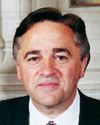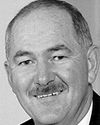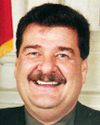Mr. Speaker, it my duty and pleasure to join in the debate concerning a constitutional amendment on the legal designation of the province of Newfoundland, which would become the province of Newfoundland and Labrador.
Normally, as history regularly reminds us, amendments to the Canadian constitution become historic highlights, important national milestones or even historic benchmarks, but the debate in the House today is less important because of the rather minor nature of this amendment.
The amendment introduced by the federal government and sponsored by the Minister of Industry reflects a diluted version of the previous position of the government of Newfoundland, and that is good. If it had been any different, the Bloc Quebecois would not have been able to support the motion, but more on that later. It should be noted that the very essence of this constitutional amendment has long been a touchy issue in the relations between the governments of Quebec and Newfoundland.
The dispute that still keeps these two governments on opposite sides concerning the recognition of the territory belonging to Labrador did not start just the other day. In fact, Canada and Newfoundland filed an appeal in 1927 with the judiciary committee of the Privy Council in London for a ruling on the delineation of the border between the two on the Labrador Peninsula. It should be pointed out that at the time Newfoundland was only a colony of the British crown, as was Canada moreover, and the Privy Council in London was the highest level of the judiciary for all colonies.
The tribunal was therefore asked to interpret the meaning of the expression “coast of Labrador”, a territory assigned to the colony of Newfoundland by certain of the colonial laws. The Government of Canada of the day, defending the territorial interests of Quebec, claimed that this meant only a narrow strip of land along the water's edge. Newfoundland, on the other hand, argued that the Newfoundland portion of Labrador extended to the entire watershed draining into the Atlantic, an area very likely far larger than any agreement could have been reached on.
The judges found in favour of Newfoundland. In addition to the entire watershed draining into the Atlantic Ocean, Newfoundland was awarded a portion of the territory to the north of the 52nd parallel, including the watershed area of the rivers draining into the St. Lawrence, thus going beyond the watershed line.
A number of commentators contested the reasons for the decision. First, it seemed that the broad definition given the expression “coast of Labrador” gave Newfoundland too much of territory Quebec considered its own. It was later alleged that the delineation of the southern border along the 52nd parallel gave Newfoundland more than it had asked for. It was noted too that the government of Quebec was not present at the hearings of the tribunal.
It is again important to point out that serious doubts were expressed about the federal government's real interest in defending the integrity of Quebec territory, since Newfoundland was already considered to be a future province in the Canadian federation. Finally, doubt was often cast on the impartiality of the judges on the judiciary committee, because the judges belonged to a government whose members had economic interests in Labrador.
We understand better today, with this historical background, the scope of the sometimes troubled relationship between Quebec and Newfoundland. However, the problem remains undiminished, and, had it not been for some softening in the traditional stand taken by Newfoundland, it would be a good bet that even the federal government would not have wanted to get involved in any debate on the matter.
At the time, the governments of Newfoundland and Canada accepted the 1927 opinion of the judicial committee of the Privy Council setting the border between these two states, or at least between these two territorial entities of the empire. In 1949, when Newfoundland joined the Canadian federation, the border defined by the 1927 decision was confirmed under the heading “Terms of Union”, enacted under the Newfoundland Act. In the schedule, the second term reads as follows:
The Province of Newfoundland shall comprise the same territory as at the date of Union, that is to say, the island of Newfoundland and the islands adjacent thereto, the Coast of Labrador as delimited in the report delivered by the Judicial Committee of His Majesty's Privy Council on the first day of March, 1927...and the islands adjacent to the said Coast of Labrador.
Never, and I insist on that word, did a Quebec government officially recognize the jurisdiction of the Newfoundland government over Labrador, as delineated by the 1927 decision. For over 70 years now, Liberal, PQ and Union nationale MNAs have always shared the same view on this issue.
In spite of this imbroglio, over the years there have been many bilateral development and co-operation agreements between Quebec and Newfoundland. Moreover, relations between the two governments greatly improved under the leadership of Premier Bouchard and of the current Minister of Industry when he was premier of Newfoundland.
However, given the relative fragility of these relations and the scope of future projects to be negotiated, Premier Bouchard warned his Newfoundland counterpart against the negative interpretation that could have been generated in Quebec by presenting a motion to officialize the name of Newfoundland and Labrador, thus legalizing and officializing the 1927 judicial decision.
In this regard, Montreal's Gazette reported in February 1997 Premier Bouchard's comments that presenting a resolution as proposed by the Newfoundland government would revive a deep emotional debate in Quebec and could be perceived as a form of provocation.
At the time, intense negotiations were taking place to conclude an agreement of $10 billion or so to jointly develop Churchill Falls' hydro electric potential.
Moreover, some semantic changes occurred in Newfoundland's position, reaching a peak on December 6, 1999, when the premier of that province, now the Minister of Industry said, and I quote:
The resolution passed by the House of Assembly and now being considered by the federal government would simply legalize what has been the boundary of this province as confirmed by the British Privy Council decision of 1927.
It went on to say that the region of the province should be acknowledged in the official name.
I insist on the word legalize, used by the then premier of Newfoundland. This gives us a better understanding of the reaction of Premier Bouchard, who considered this as an insult to the constant position of Quebec on the border issue.
Again, I remind the House that no government in Quebec, whatever its political stripe, has ever recognized the legal status of the border drawn pursuant under the judiciary decision of 1927.
Obviously, Newfoundland's position as presented and defended by the Minister of Industry, is not the same today, if we compare it to the position he had when he was a member of parliament in St. John's.
Things have evolved considerably, since the Minister of Industry has softened his position by making clear in a letter to Premier Bernard Landry, and I quote:
That the amendment proposal aiming at changing the name of Newfoundland will have no impact on the present border between Quebec and Newfoundland.
Replacing the name of Newfoundland by Newfoundland and Labrador in the Terms of Union is a symbolic measure which acknowledges in a significant way that Labrador is an essential and full partner of the province, with its own geography, history and culture.
The Minister of Industry reaffirmed this commitment today when he brought forward his motion, just half an hour ago.
In a letter to Premier Landry dated October 23rd, Mr. Grimes, the successor of the Minister of Industry and current premier of Newfoundland, took a similar position.
He wrote, and I quote:
I wish to reiterate that this is only a change of name, which in no way changes our position regarding our common border or our position on the issue.
Essentially, it is to be understood from those words that the government of Newfoundland explicitly acknowledges that nothing in the terms of the motion of the government will have any impact on the delimitation of the border between Quebec and Newfoundland.
Incidentally, this guarantee was required as a sine qua non condition for the approval by Quebec of the constitutional initiative of Newfoundland, as stated in the letter of October 18 signed by Mr. Facal and Mr. Brassard, both ministers in the government of Quebec.
The fact that some wish to amend the constitution to facilitate the recognition of Quebec as a nation appears to me to be correct, desirable, but also very unlikely, if not impossible. Unfortunately Quebecers have too often been disappointed by the endless constitutional rounds to rejoice about it, as the populations of Newfoundland and Labrador can today.
This is particularly true, given the disconcerting ease with which this historic amendment to the constitution that we are debating today will be enacted. It would appear, once again, as though the federal government is biased toward Newfoundland and the other provinces of Canada, to the exclusion, of course, of Quebec.
A few days before the 1998 Quebec elections, the Prime Minister of Canada stated, in response to comments made by Jean Charest, that the Canadian constitution was not a general store, and the Government of Canada had no intention of reopening the issue; that there should be no expectations of the federal government changing the constitution; and that everything was coming up roses.
Last spring, the Canadian Minister of Intergovernmental Affairs even took pains to explain why Quebec's nationhood would not be recognized in the constitution, ridiculing Quebecers' constitutional demands by stating in an open letter to La Presse , on May 1, and I quote:
We simply refuse to make the mistake of believing that we have to put everything that is important in the constitution.
The minister continued with a highly questionable example, which now contradicts the government, by writing, and I quote again:
A great many things that are important are not found in the constitution. The most important of values, love, is not recognized...The fact that our constitution makes no mention of it does not mean that love does not exist...but I believe this to be fundamental: a constitution is not meant to contain everything that is important, but rather everything for which there are legal consequences.
Yet, according to the federal government and the government of Newfoundland, the constitutional amendment designating the “Province of Newfoundland” as the “Province of Newfoundland and Labrador” will have no impact on the borders of Labrador. Why, then, should such a request even be considered? The question remains to be answered, but the debate is pointless, according to the federal government's interpretation.
I already anticipate the triumphalist and trite remarks of the Prime Minister and his Minister of Intergovernmental Affairs, who will brag, even before the ink from the Governor General's pen has dried, that the Canadian federation is flexible and that everyone stands to gain. At the point where we are now, I hope at least that the Labrador people will be able to find love for their province. In any case, this is practically the only thing that they will be able to hope to get from the Minister of Industry.
The Quebec government has noted the change in direction or goal of the Newfoundland government on this sensitive issue and agrees with it, in light of the details of the text of the motion. However, it is important to specify that Quebec's current position remains unchanged: it does not recognize the definitive nature of the 1927 border between Quebec and Newfoundland in the Labrador peninsula. Indeed, Quebec's official maps reflect this position very accurately, while indicating the watershed divide north of the 52th parallel.
The Bloc Quebecois will not oppose the motion and wishes that the openness of the federal government may be able to affect the whole of its rather deficient interpretation, must we remind the House, of its own constitution.
Let us remember, of course, that this is a minor change to the constitution. In fact, it is a cosmetic change to Canada's primary statute, which would have no impact, except perhaps for a stronger feeling of belonging for the 30,000 inhabitants of Labrador in the province of Newfoundland.
Finally, before concluding my remarks, I would like to draw the House's attention to something which was pointed out to me and which is of paramount importance. According to the Dictionnaire illustré des noms et lieux du Québec of the Commission de toponymie du Québec, the geographic name “Labrador” can designate the “entire peninsula between Hudson Bay and the axis of the St. Lawrence River”. In other words, regardless of where the interprovincial boundary lies, there is a Quebec Labrador bounded on the west by Hudson Bay and on the east by the Quebec-Newfoundland border, wherever that border lies.
The 1927 arbitration seems to reflect this geographic reality, because its purpose was to decide on the border separating the province of Quebec and the colony of Newfoundland “in the Labrador peninsula”, according to the wording of the compromise submitted to the judges. In addition, the Privy Council was asked to rule on the legal and geographic meaning of “coast of Labrador” in certain crown documents giving the government of Newfoundland rights over this “coast”.
Newfoundland's use of the geographic name “Labrador” could be viewed as incorrect from a constitutional point of view. In fact, article 2 of the Terms of Union of Newfoundland with Canada uses the expression coast of Labrador to designate the continental portion of the territory of the new province. Newfoundland therefore cannot claim to take in all of Labrador in the geographic sense.
Finally, and very briefly, for all the reasons given earlier by the Bloc Quebecois, we will not be opposing this motion.












